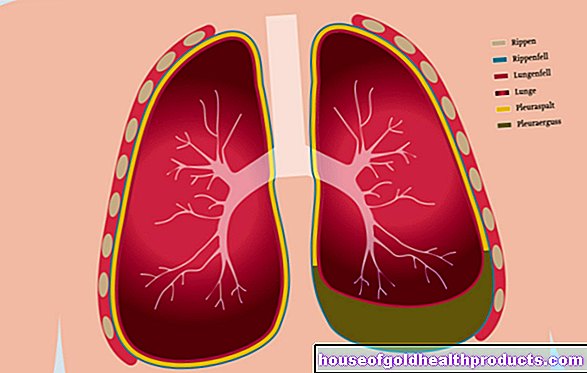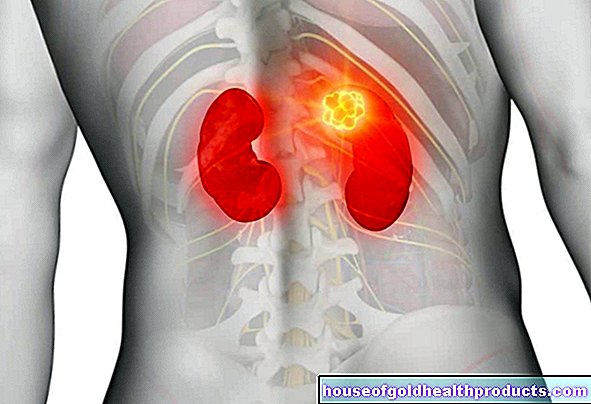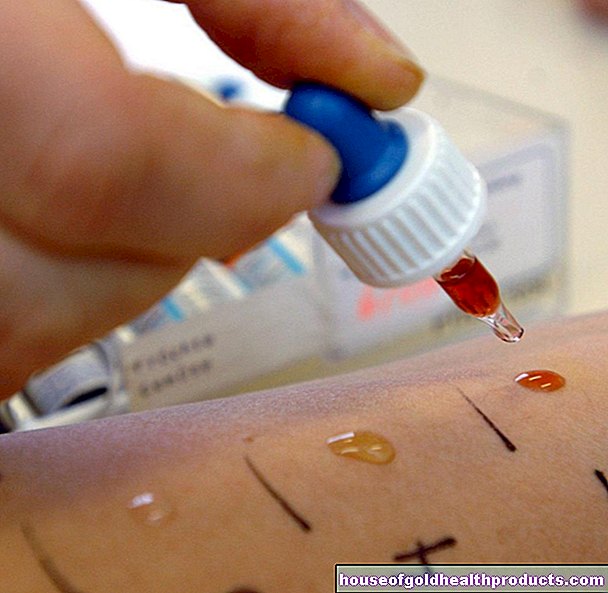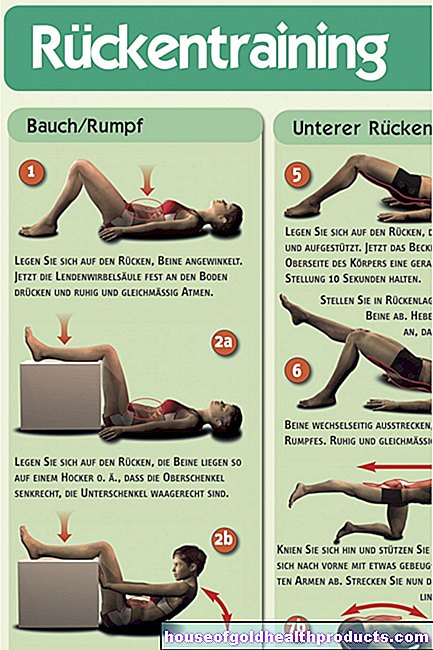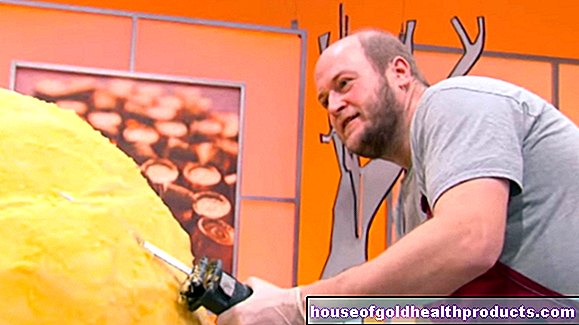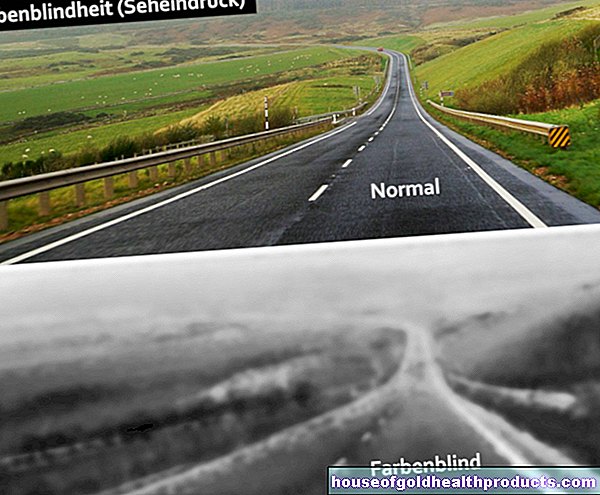Outer ligament tear
Clemens Gödel is a freelancer for the medical team.
More about the experts All content is checked by medical journalists.A torn outer ligament is usually understood to mean a torn ligament on the upper ankle - a typical sports injury. Classic symptoms are tenderness, swelling, and a bruise. The diagnosis can usually be made by examining the joint. A ruptured ligament is almost always treated conservatively. Read everything you need to know about the outer ligament tear here: causes, symptoms, diagnostics and therapy!
ICD codes for this disease: ICD codes are internationally recognized codes for medical diagnoses. They can be found, for example, in doctor's letters or on certificates of incapacity for work. S83S93
Outer ligament tear: description
A rupture of the outer ligament on the upper ankle is one of the most common sports injuries - along with damage to the knee. Women are affected more often than men. While the rupture of the lateral ligament often occurs in isolation in young people, in older people it is often accompanied by a fracture of the lateral malleolus (the distended lower end of the fibula). In children, the injuries are mainly in the area of the growth plate of the bone.
The main task of the upper ankle is to raise and lower the forefoot. It is stabilized by several ligaments, including the outer ligament. This consists of three different parts of the tape:
- Ligamentum talofibulare anterius: connects the anterior border of the lateral malleolus with the talus bone (one of the tarsal bones)
- Posterior talofibular ligament: connects the inside of the outer malleolus to the talus bone
- Calcaneofibular ligament: connects the lateral malleolus to the calcaneus
The weak anterior talofibular ligament is most often affected when the lateral ligament ruptures. In about 20 percent of cases, both this ligament and the calcaneofibular ligament tear. The strongest of the three ligaments, the posterior talofibular ligament, rarely tears. All three ligaments tear only when subjected to strong force.
An outer ligament tear can be complete or only partial (ligament tear).
Rupture of the lateral ligament: symptoms
Those affected sometimes perceive an outer ligament tear at the upper ankle as a palpable “crack”. Often it is no longer possible to step on the injured foot, but sometimes those affected can still walk with a hobble. Severe swelling develops on the ankle. The area of the torn ligament is tender on pressure.
Lateral ligament tear: causes and risk factors
An outer ligament tear can occur if the foot kinks outwards while walking or running, for example. In everyday life, an uneven or slippery floor, stairs or curbs can become traps.
Athletes usually bend over due to uncontrolled movements, when colliding with an opponent or when landing after a jump. The risk of an outer ligament rupture is particularly high in sports with frequent changes of direction, short sprints and quick stopping movements, such as football, tennis and volleyball.
Risk factors for an external ligament tear are poor training condition, weak muscles, contractures or shortening of muscles, tendons or the joint capsule. Nerve damage, which leads to poor perception of the position of the feet and joints, also increases the risk of a ruptured ligament. While a lack of experience in the practice of a sport also poses a risk, high-performance athletes are also particularly at risk. Overweight and high heels can also promote a tear in the outer ligament.
In rare cases, apart from tearing the ligament, there are also injuries to bones or cartilage.
Lateral ligament tear: examinations and diagnosis
If you suspect an outer ligament rupture, you should contact an orthopedic surgeon, trauma surgeon or sports medicine specialist. First of all, the doctor will collect important information from the patient. He asks the following questions, among others:
- How did the injury happen?
- Where is the pain localized?
- Can you still stand on the affected foot?
- Did you have to stop the work you did before the injury?
- Have you already had an injury on that foot?
The doctor will then examine the affected foot carefully. As with any injury, it must first be checked whether the blood circulation, motor skills and sensitivity of the foot are preserved. Already when looking at an outer ligament tear, a significant swelling and a bruise on the ankle are usually noticeable.
A misalignment of the foot usually indicates a bony injury. However, deviations in the joint position are also possible with a single outer ligament tear.
If the patient feels pressure pain under the outer ankle when palpating the foot, this indicates a rupture of the outer ligament. A pressure pain on bone points, however, indicates a bone fracture.
The combination of pressure pain and bruising make an external ligament injury very likely.
Special tests check the function of the outer band. The so-called drawer test is used to test the stability of the upper ankle joint. To do this, the doctor tries to push the foot forward with the knee bent and the shin fixed. In this way, an instability can be determined by comparing the sides (talus advancement). Another test is the inversion stress test to determine if a calcaneofibular ligament ruptures.
If the outer ligament is torn, the ankle can often be "opened up" to the side (stronger O-position compared to the uninjured ankle on the other foot).
Since there are a multitude of muscles, tendons and ligaments in the foot, the outer ligament examination should also consider alternative diagnoses, such as a ruptured Achilles tendon.
Imaging
Imaging is not always necessary. An X-ray examination can clarify whether there are bony injuries in addition to the outer ligament tear (e.g. a bony ligament tear). Sometimes so-called held recordings are also made. The foot is fixed in a position in order to examine the "ability to fold" the upper ankle joint and to indirectly detect a rupture of the outer ligament.
For further diagnosis, computed tomography (CT) or magnetic resonance imaging (MRI) are performed less often. A rupture of the outer ligament and other connective tissue injuries can usually be seen well, especially in an MRI scan.
External ligament tear: treatment
A rupture of the outer ligament usually does not need to be operated on. It has been shown that a functionally good result can be achieved without surgery even with many severe injuries to the external ligament apparatus.
Immediate action
The first aid measures in the event of a ruptured ligament are based on the PECH rule (break, ice, compression, elevation): If necessary, interrupt the sporting activity, raise the ankle joint, cool it (e.g. with ice or cold water) and apply a pressure bandage (against the swelling that is beginning). If necessary, pain relievers (such as ibuprofen) can be taken to relieve the pain.
Conservative therapy
Functional treatment is usually carried out with a special orthosis (ankle splint) that the patient should wear for up to six weeks. It prevents you from twisting your ankle again. In the first week, the foot should be completely relieved (with the help of forearm crutches); then follows - in adaptation to the pain - a rapid increase in the load.
Taping is usually not enough at the beginning of the treatment, but can be used by experienced users to support the treatment.
Consistent immobilization is almost only necessary in the case of considerable pain. A plaster splint is only used rarely and for a few days. After that, the described protection against re-kinking with splints is usually sufficient.
surgery
Only in a few cases does a torn ligament need to be treated surgically. Surgery is considered in the following situations:
- Outer ligament tear of all three ligaments
- additional cartilage / bone damage
- complete instability of the joint
- Axial deviation of the joint
- severe cases of chronic instability
- Failure of conservative therapy
- Rupture of the outer ligament in professional athletes
The advantages of surgery are a lower rate of recurrence of the lateral ligament tear and a reduction in joint instability. However, even with this apparently small procedure, there is a certain surgical risk, which must be taken into account.
After an operation, the ankle is usually immobilized in a splint for one to two weeks. This is followed by a functional follow-up treatment with an orthosis or a so-called stable shoe. The rehabilitation takes about three to four months in total.
physical therapy
Regardless of the type of treatment, physiotherapeutic measures should be started at an early stage after an external ligament rupture. The aim is to strengthen the muscles in the ankle area in order to better stabilize the joint. Balance training (e.g. on a wobbly board) is also useful. In the course of the training, the load is increased until the pain-free full load is reached. Support bandages can facilitate training and the later return to sport.
Lateral ligament tear: disease course and prognosis
There are seldom complications after an external ligament rupture. The prognosis is usually very good. Usually, the doctor prescribes physiotherapy treatment after an external ligament rupture to promote healing. The rehabilitation period is around four to twelve weeks. The natural repair processes in the tissue can take up to a year.
In about the first two months after the outer ligament rupture, those affected should refrain from exercising, which puts a lot of strain on the outer ligaments.
Residual symptoms such as a tendency to swelling can last for several months, but usually go away completely.
Joint stiffening or long-term joint wear (arthrosis) rarely occurs after an outer ligament rupture. If the initial pain does not decrease, an ankle joint impingement or an (overlooked) shear fracture must be considered. Impingement involves entrapment of soft tissues such as ligaments.
Within one year of the injury, there is about twice the risk of a new rupture of the outer ligament compared to the average population. The instability can sometimes be compensated for with consistent physiotherapy. In up to 40 percent of cases, mechanical instabilities remain, which can make an operation necessary.
prevention
In order to prevent an outer ligament rupture, one should warm up sufficiently before exercising. Avoid one-sided exposure. Compensatory gymnastics or exercise helps to build up supporting muscles (especially in the ankle area). Those who tend to twist their ligaments and tear their ligaments can support their ankles with sports bandages or tapes. Shoes with a high shaft also protect against an outer ligament tear.
Tags: news sports fitness prevention






